ARTD2038: Introduction to Visual Culture - Self-Portrait vs. Selfie
VerifiedAdded on 2021/01/08
|12
|4161
|117
Essay
AI Summary
This essay, "Self-Expression: From Self-Portrait to Selfie," explores the historical and contemporary significance of self-representation in visual culture. The essay begins by tracing the history of self-portraits, from iconic works like Parmigianino's "Self-portrait in A Convex Mirror" to the rise of photography and its impact on portraiture. It then examines the emergence of the selfie, its rise to prominence, and its role in contemporary society, including celebrity culture and social media platforms like Instagram. The essay analyzes the concept of "filtered reality" in selfies, discussing how individuals use them to curate their self-image. It also delves into the controversies surrounding selfies, such as funeral selfies and nude selfies, and their implications. The essay concludes by emphasizing the selfie's evolution as a new form of self-expression and its impact on photography theory and visual culture, highlighting the ongoing interplay between technology, art, and personal identity.
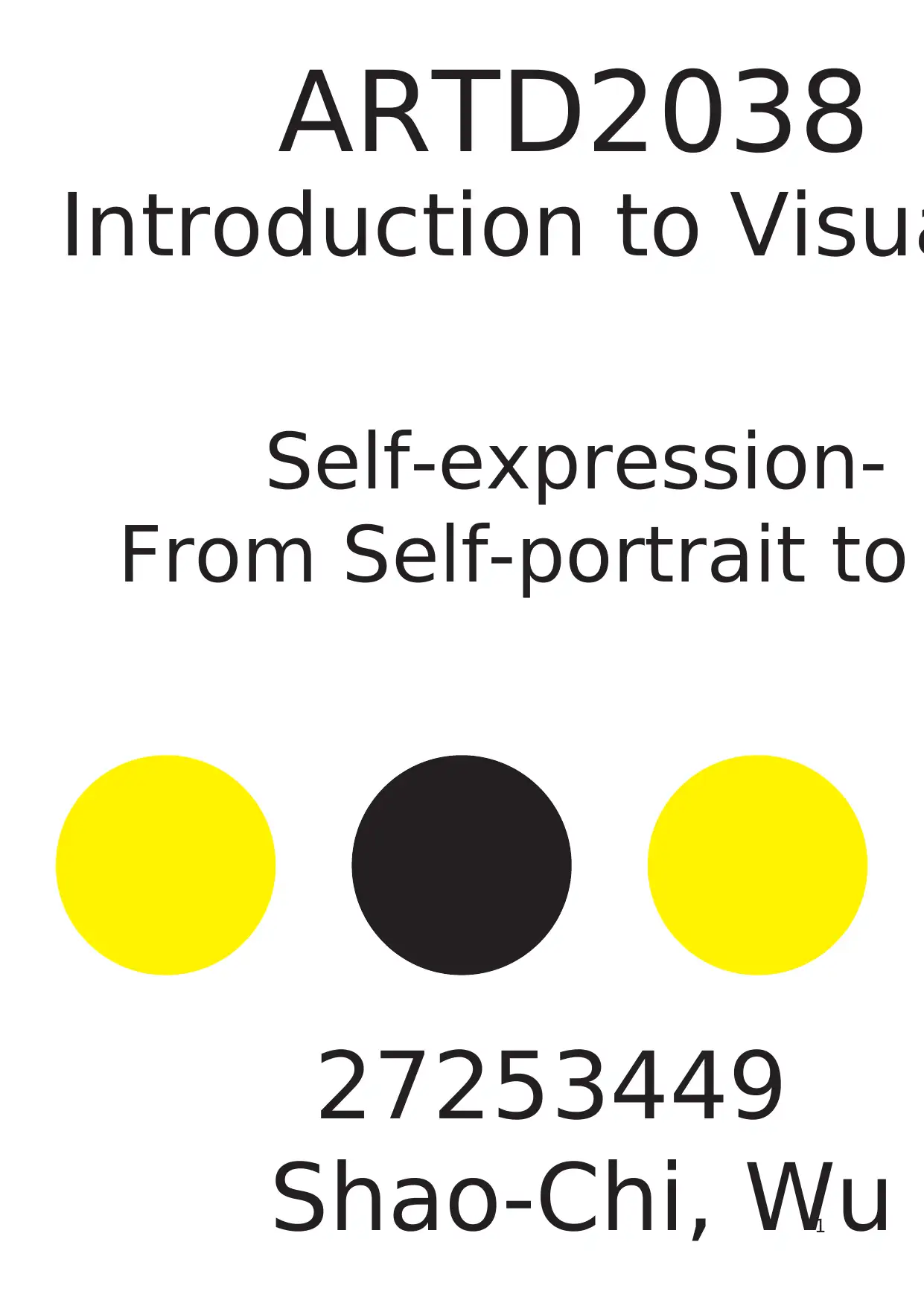
1
ARTD2038
Introduction to Visua
27253449
Shao-Chi, Wu
Self-expression-
From Self-portrait to
ARTD2038
Introduction to Visua
27253449
Shao-Chi, Wu
Self-expression-
From Self-portrait to
Paraphrase This Document
Need a fresh take? Get an instant paraphrase of this document with our AI Paraphraser
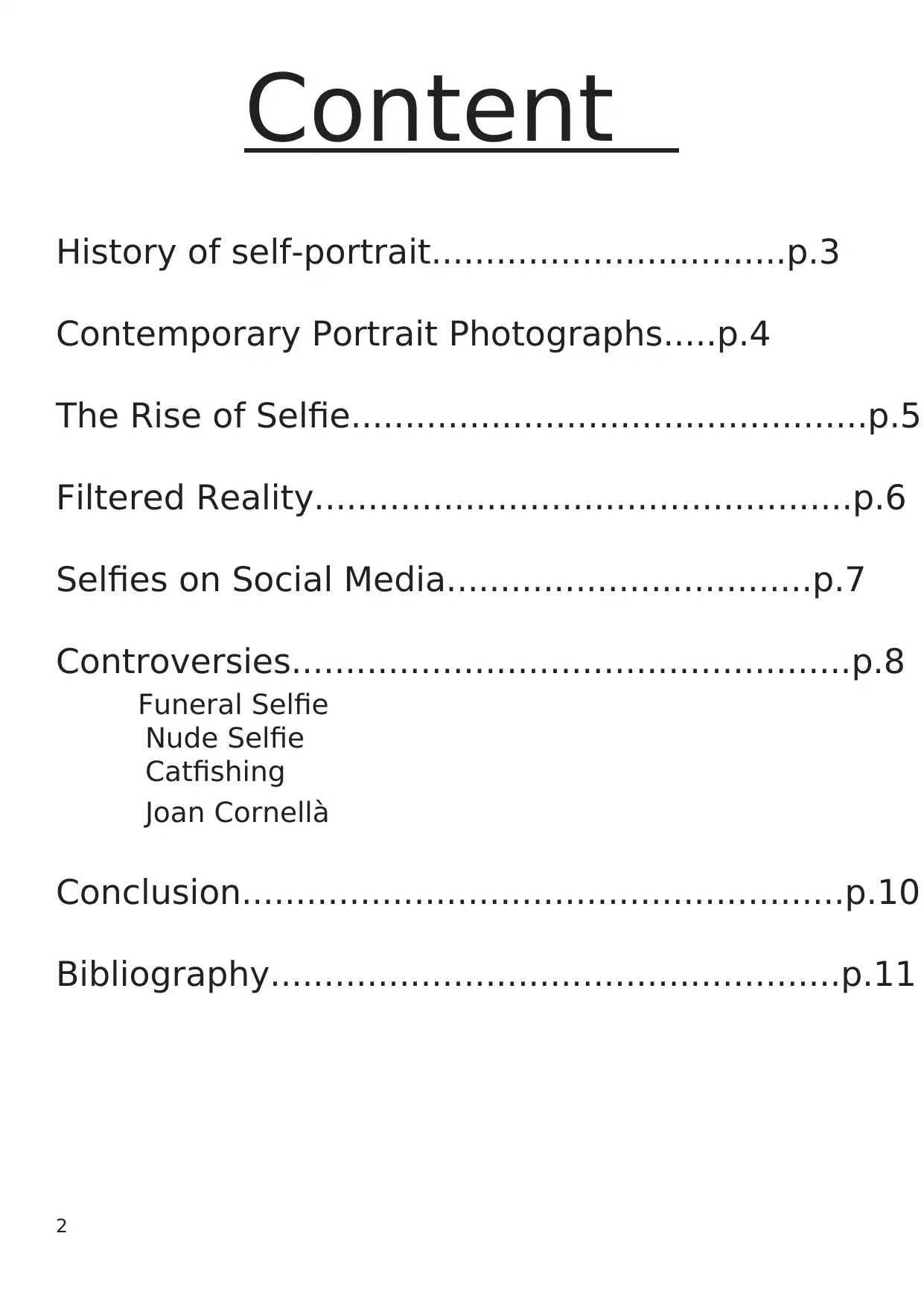
2
Content
History of self-portrait.................................p.3
Contemporary Portrait Photographs.....p.4
The Rise of Selfie................................................p.5
Filtered Reality..................................................p.6
Selfies on Social Media..................................p.7
Controversies....................................................p.8
Funeral Selfie
Nude Selfie
Catfishing
Joan Cornellà
Conclusion........................................................p.10
Bibliography.....................................................p.11
Content
History of self-portrait.................................p.3
Contemporary Portrait Photographs.....p.4
The Rise of Selfie................................................p.5
Filtered Reality..................................................p.6
Selfies on Social Media..................................p.7
Controversies....................................................p.8
Funeral Selfie
Nude Selfie
Catfishing
Joan Cornellà
Conclusion........................................................p.10
Bibliography.....................................................p.11
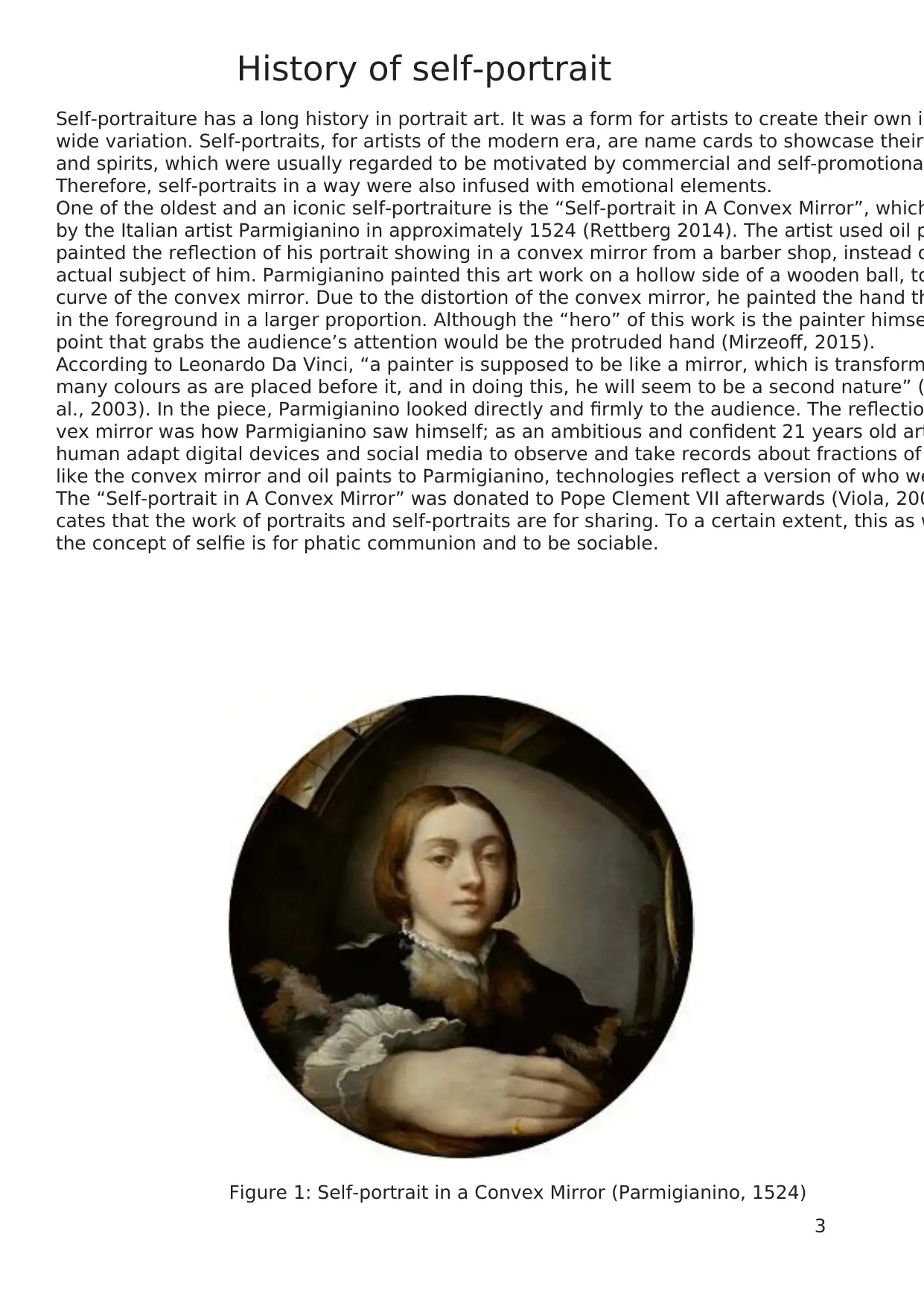
3
History of self-portrait
Self-portraiture has a long history in portrait art. It was a form for artists to create their own im
wide variation. Self-portraits, for artists of the modern era, are name cards to showcase their
and spirits, which were usually regarded to be motivated by commercial and self-promotiona
Therefore, self-portraits in a way were also infused with emotional elements.
One of the oldest and an iconic self-portraiture is the “Self-portrait in A Convex Mirror”, which
by the Italian artist Parmigianino in approximately 1524 (Rettberg 2014). The artist used oil p
painted the reflection of his portrait showing in a convex mirror from a barber shop, instead o
actual subject of him. Parmigianino painted this art work on a hollow side of a wooden ball, to
curve of the convex mirror. Due to the distortion of the convex mirror, he painted the hand th
in the foreground in a larger proportion. Although the “hero” of this work is the painter himse
point that grabs the audience’s attention would be the protruded hand (Mirzeoff, 2015).
According to Leonardo Da Vinci, “a painter is supposed to be like a mirror, which is transform
many colours as are placed before it, and in doing this, he will seem to be a second nature” (
al., 2003). In the piece, Parmigianino looked directly and firmly to the audience. The reflectio
vex mirror was how Parmigianino saw himself; as an ambitious and confident 21 years old art
human adapt digital devices and social media to observe and take records about fractions of
like the convex mirror and oil paints to Parmigianino, technologies reflect a version of who we
The “Self-portrait in A Convex Mirror” was donated to Pope Clement VII afterwards (Viola, 200
cates that the work of portraits and self-portraits are for sharing. To a certain extent, this as w
the concept of selfie is for phatic communion and to be sociable.
Figure 1: Self-portrait in a Convex Mirror (Parmigianino, 1524)
History of self-portrait
Self-portraiture has a long history in portrait art. It was a form for artists to create their own im
wide variation. Self-portraits, for artists of the modern era, are name cards to showcase their
and spirits, which were usually regarded to be motivated by commercial and self-promotiona
Therefore, self-portraits in a way were also infused with emotional elements.
One of the oldest and an iconic self-portraiture is the “Self-portrait in A Convex Mirror”, which
by the Italian artist Parmigianino in approximately 1524 (Rettberg 2014). The artist used oil p
painted the reflection of his portrait showing in a convex mirror from a barber shop, instead o
actual subject of him. Parmigianino painted this art work on a hollow side of a wooden ball, to
curve of the convex mirror. Due to the distortion of the convex mirror, he painted the hand th
in the foreground in a larger proportion. Although the “hero” of this work is the painter himse
point that grabs the audience’s attention would be the protruded hand (Mirzeoff, 2015).
According to Leonardo Da Vinci, “a painter is supposed to be like a mirror, which is transform
many colours as are placed before it, and in doing this, he will seem to be a second nature” (
al., 2003). In the piece, Parmigianino looked directly and firmly to the audience. The reflectio
vex mirror was how Parmigianino saw himself; as an ambitious and confident 21 years old art
human adapt digital devices and social media to observe and take records about fractions of
like the convex mirror and oil paints to Parmigianino, technologies reflect a version of who we
The “Self-portrait in A Convex Mirror” was donated to Pope Clement VII afterwards (Viola, 200
cates that the work of portraits and self-portraits are for sharing. To a certain extent, this as w
the concept of selfie is for phatic communion and to be sociable.
Figure 1: Self-portrait in a Convex Mirror (Parmigianino, 1524)
⊘ This is a preview!⊘
Do you want full access?
Subscribe today to unlock all pages.

Trusted by 1+ million students worldwide
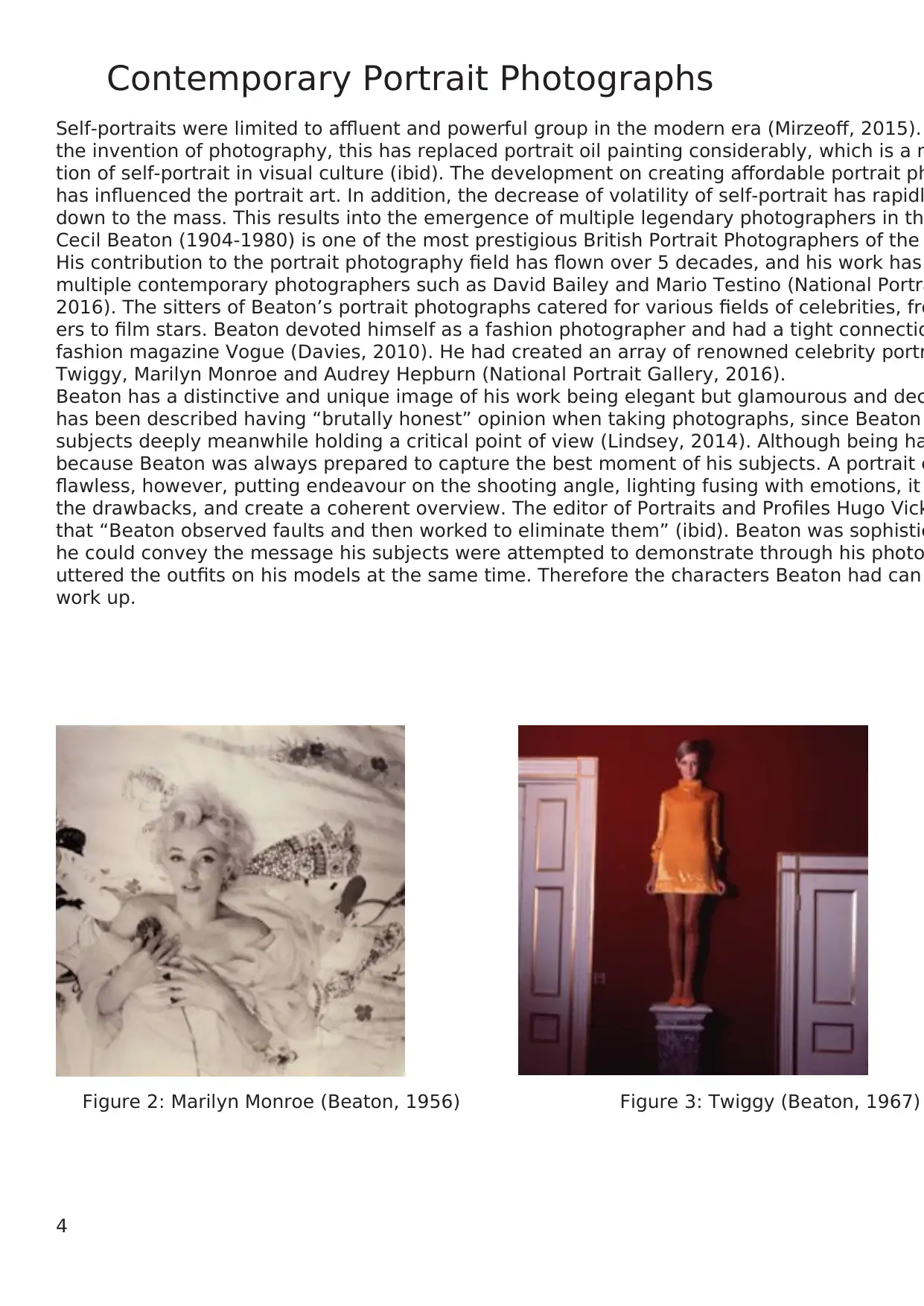
4
Contemporary Portrait Photographs
Self-portraits were limited to affluent and powerful group in the modern era (Mirzeoff, 2015).
the invention of photography, this has replaced portrait oil painting considerably, which is a n
tion of self-portrait in visual culture (ibid). The development on creating affordable portrait ph
has influenced the portrait art. In addition, the decrease of volatility of self-portrait has rapidl
down to the mass. This results into the emergence of multiple legendary photographers in th
Cecil Beaton (1904-1980) is one of the most prestigious British Portrait Photographers of the
His contribution to the portrait photography field has flown over 5 decades, and his work has
multiple contemporary photographers such as David Bailey and Mario Testino (National Portra
2016). The sitters of Beaton’s portrait photographs catered for various fields of celebrities, fro
ers to film stars. Beaton devoted himself as a fashion photographer and had a tight connectio
fashion magazine Vogue (Davies, 2010). He had created an array of renowned celebrity portr
Twiggy, Marilyn Monroe and Audrey Hepburn (National Portrait Gallery, 2016).
Beaton has a distinctive and unique image of his work being elegant but glamourous and dec
has been described having “brutally honest” opinion when taking photographs, since Beaton
subjects deeply meanwhile holding a critical point of view (Lindsey, 2014). Although being ha
because Beaton was always prepared to capture the best moment of his subjects. A portrait c
flawless, however, putting endeavour on the shooting angle, lighting fusing with emotions, it
the drawbacks, and create a coherent overview. The editor of Portraits and Profiles Hugo Vick
that “Beaton observed faults and then worked to eliminate them” (ibid). Beaton was sophistic
he could convey the message his subjects were attempted to demonstrate through his photo
uttered the outfits on his models at the same time. Therefore the characters Beaton had can
work up.
Figure 2: Marilyn Monroe (Beaton, 1956) Figure 3: Twiggy (Beaton, 1967)
Contemporary Portrait Photographs
Self-portraits were limited to affluent and powerful group in the modern era (Mirzeoff, 2015).
the invention of photography, this has replaced portrait oil painting considerably, which is a n
tion of self-portrait in visual culture (ibid). The development on creating affordable portrait ph
has influenced the portrait art. In addition, the decrease of volatility of self-portrait has rapidl
down to the mass. This results into the emergence of multiple legendary photographers in th
Cecil Beaton (1904-1980) is one of the most prestigious British Portrait Photographers of the
His contribution to the portrait photography field has flown over 5 decades, and his work has
multiple contemporary photographers such as David Bailey and Mario Testino (National Portra
2016). The sitters of Beaton’s portrait photographs catered for various fields of celebrities, fro
ers to film stars. Beaton devoted himself as a fashion photographer and had a tight connectio
fashion magazine Vogue (Davies, 2010). He had created an array of renowned celebrity portr
Twiggy, Marilyn Monroe and Audrey Hepburn (National Portrait Gallery, 2016).
Beaton has a distinctive and unique image of his work being elegant but glamourous and dec
has been described having “brutally honest” opinion when taking photographs, since Beaton
subjects deeply meanwhile holding a critical point of view (Lindsey, 2014). Although being ha
because Beaton was always prepared to capture the best moment of his subjects. A portrait c
flawless, however, putting endeavour on the shooting angle, lighting fusing with emotions, it
the drawbacks, and create a coherent overview. The editor of Portraits and Profiles Hugo Vick
that “Beaton observed faults and then worked to eliminate them” (ibid). Beaton was sophistic
he could convey the message his subjects were attempted to demonstrate through his photo
uttered the outfits on his models at the same time. Therefore the characters Beaton had can
work up.
Figure 2: Marilyn Monroe (Beaton, 1956) Figure 3: Twiggy (Beaton, 1967)
Paraphrase This Document
Need a fresh take? Get an instant paraphrase of this document with our AI Paraphraser
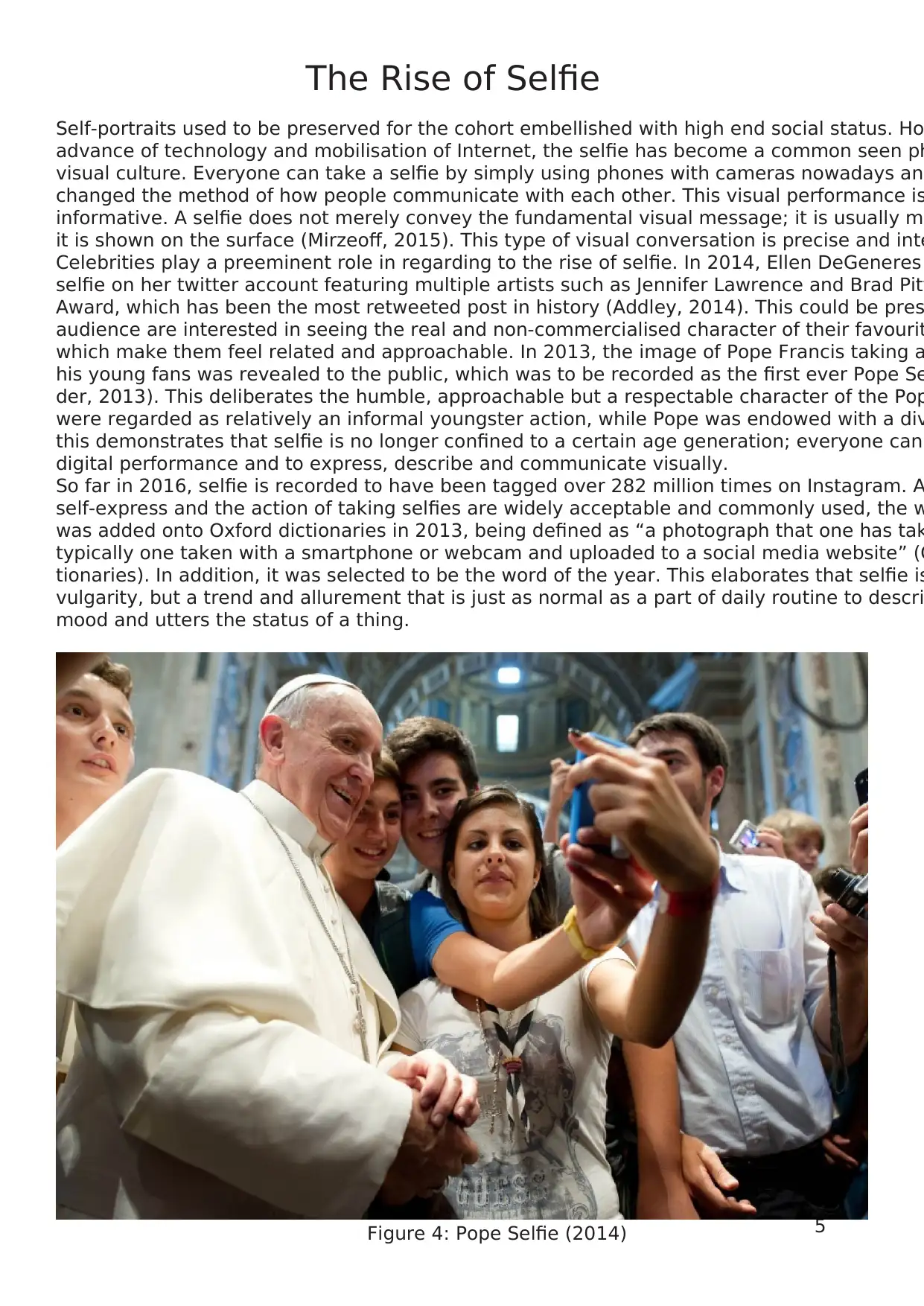
5
The Rise of Selfie
Self-portraits used to be preserved for the cohort embellished with high end social status. Ho
advance of technology and mobilisation of Internet, the selfie has become a common seen ph
visual culture. Everyone can take a selfie by simply using phones with cameras nowadays an
changed the method of how people communicate with each other. This visual performance is
informative. A selfie does not merely convey the fundamental visual message; it is usually m
it is shown on the surface (Mirzeoff, 2015). This type of visual conversation is precise and inte
Celebrities play a preeminent role in regarding to the rise of selfie. In 2014, Ellen DeGeneres
selfie on her twitter account featuring multiple artists such as Jennifer Lawrence and Brad Pitt
Award, which has been the most retweeted post in history (Addley, 2014). This could be pres
audience are interested in seeing the real and non-commercialised character of their favourit
which make them feel related and approachable. In 2013, the image of Pope Francis taking a
his young fans was revealed to the public, which was to be recorded as the first ever Pope Se
der, 2013). This deliberates the humble, approachable but a respectable character of the Pop
were regarded as relatively an informal youngster action, while Pope was endowed with a div
this demonstrates that selfie is no longer confined to a certain age generation; everyone can
digital performance and to express, describe and communicate visually.
So far in 2016, selfie is recorded to have been tagged over 282 million times on Instagram. A
self-express and the action of taking selfies are widely acceptable and commonly used, the w
was added onto Oxford dictionaries in 2013, being defined as “a photograph that one has tak
typically one taken with a smartphone or webcam and uploaded to a social media website” (O
tionaries). In addition, it was selected to be the word of the year. This elaborates that selfie is
vulgarity, but a trend and allurement that is just as normal as a part of daily routine to descri
mood and utters the status of a thing.
Figure 4: Pope Selfie (2014)
The Rise of Selfie
Self-portraits used to be preserved for the cohort embellished with high end social status. Ho
advance of technology and mobilisation of Internet, the selfie has become a common seen ph
visual culture. Everyone can take a selfie by simply using phones with cameras nowadays an
changed the method of how people communicate with each other. This visual performance is
informative. A selfie does not merely convey the fundamental visual message; it is usually m
it is shown on the surface (Mirzeoff, 2015). This type of visual conversation is precise and inte
Celebrities play a preeminent role in regarding to the rise of selfie. In 2014, Ellen DeGeneres
selfie on her twitter account featuring multiple artists such as Jennifer Lawrence and Brad Pitt
Award, which has been the most retweeted post in history (Addley, 2014). This could be pres
audience are interested in seeing the real and non-commercialised character of their favourit
which make them feel related and approachable. In 2013, the image of Pope Francis taking a
his young fans was revealed to the public, which was to be recorded as the first ever Pope Se
der, 2013). This deliberates the humble, approachable but a respectable character of the Pop
were regarded as relatively an informal youngster action, while Pope was endowed with a div
this demonstrates that selfie is no longer confined to a certain age generation; everyone can
digital performance and to express, describe and communicate visually.
So far in 2016, selfie is recorded to have been tagged over 282 million times on Instagram. A
self-express and the action of taking selfies are widely acceptable and commonly used, the w
was added onto Oxford dictionaries in 2013, being defined as “a photograph that one has tak
typically one taken with a smartphone or webcam and uploaded to a social media website” (O
tionaries). In addition, it was selected to be the word of the year. This elaborates that selfie is
vulgarity, but a trend and allurement that is just as normal as a part of daily routine to descri
mood and utters the status of a thing.
Figure 4: Pope Selfie (2014)
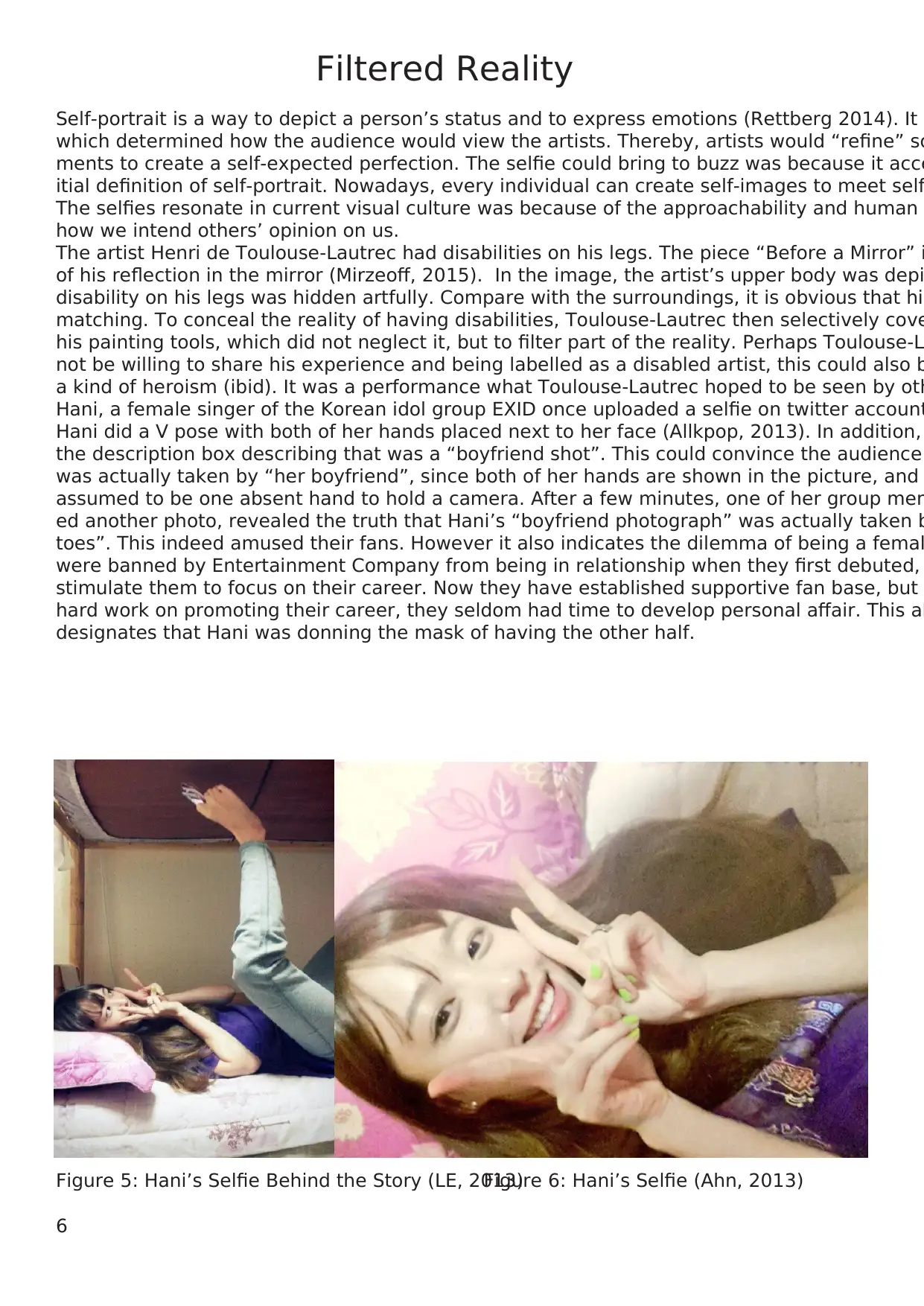
6
Filtered Reality
Self-portrait is a way to depict a person’s status and to express emotions (Rettberg 2014). It
which determined how the audience would view the artists. Thereby, artists would “refine” so
ments to create a self-expected perfection. The selfie could bring to buzz was because it acce
itial definition of self-portrait. Nowadays, every individual can create self-images to meet self
The selfies resonate in current visual culture was because of the approachability and human
how we intend others’ opinion on us.
The artist Henri de Toulouse-Lautrec had disabilities on his legs. The piece “Before a Mirror” i
of his reflection in the mirror (Mirzeoff, 2015). In the image, the artist’s upper body was depi
disability on his legs was hidden artfully. Compare with the surroundings, it is obvious that his
matching. To conceal the reality of having disabilities, Toulouse-Lautrec then selectively cove
his painting tools, which did not neglect it, but to filter part of the reality. Perhaps Toulouse-L
not be willing to share his experience and being labelled as a disabled artist, this could also b
a kind of heroism (ibid). It was a performance what Toulouse-Lautrec hoped to be seen by oth
Hani, a female singer of the Korean idol group EXID once uploaded a selfie on twitter account
Hani did a V pose with both of her hands placed next to her face (Allkpop, 2013). In addition,
the description box describing that was a “boyfriend shot”. This could convince the audience
was actually taken by “her boyfriend”, since both of her hands are shown in the picture, and
assumed to be one absent hand to hold a camera. After a few minutes, one of her group mem
ed another photo, revealed the truth that Hani’s “boyfriend photograph” was actually taken b
toes”. This indeed amused their fans. However it also indicates the dilemma of being a femal
were banned by Entertainment Company from being in relationship when they first debuted,
stimulate them to focus on their career. Now they have established supportive fan base, but
hard work on promoting their career, they seldom had time to develop personal affair. This al
designates that Hani was donning the mask of having the other half.
Figure 5: Hani’s Selfie Behind the Story (LE, 2013)Figure 6: Hani’s Selfie (Ahn, 2013)
Filtered Reality
Self-portrait is a way to depict a person’s status and to express emotions (Rettberg 2014). It
which determined how the audience would view the artists. Thereby, artists would “refine” so
ments to create a self-expected perfection. The selfie could bring to buzz was because it acce
itial definition of self-portrait. Nowadays, every individual can create self-images to meet self
The selfies resonate in current visual culture was because of the approachability and human
how we intend others’ opinion on us.
The artist Henri de Toulouse-Lautrec had disabilities on his legs. The piece “Before a Mirror” i
of his reflection in the mirror (Mirzeoff, 2015). In the image, the artist’s upper body was depi
disability on his legs was hidden artfully. Compare with the surroundings, it is obvious that his
matching. To conceal the reality of having disabilities, Toulouse-Lautrec then selectively cove
his painting tools, which did not neglect it, but to filter part of the reality. Perhaps Toulouse-L
not be willing to share his experience and being labelled as a disabled artist, this could also b
a kind of heroism (ibid). It was a performance what Toulouse-Lautrec hoped to be seen by oth
Hani, a female singer of the Korean idol group EXID once uploaded a selfie on twitter account
Hani did a V pose with both of her hands placed next to her face (Allkpop, 2013). In addition,
the description box describing that was a “boyfriend shot”. This could convince the audience
was actually taken by “her boyfriend”, since both of her hands are shown in the picture, and
assumed to be one absent hand to hold a camera. After a few minutes, one of her group mem
ed another photo, revealed the truth that Hani’s “boyfriend photograph” was actually taken b
toes”. This indeed amused their fans. However it also indicates the dilemma of being a femal
were banned by Entertainment Company from being in relationship when they first debuted,
stimulate them to focus on their career. Now they have established supportive fan base, but
hard work on promoting their career, they seldom had time to develop personal affair. This al
designates that Hani was donning the mask of having the other half.
Figure 5: Hani’s Selfie Behind the Story (LE, 2013)Figure 6: Hani’s Selfie (Ahn, 2013)
⊘ This is a preview!⊘
Do you want full access?
Subscribe today to unlock all pages.

Trusted by 1+ million students worldwide
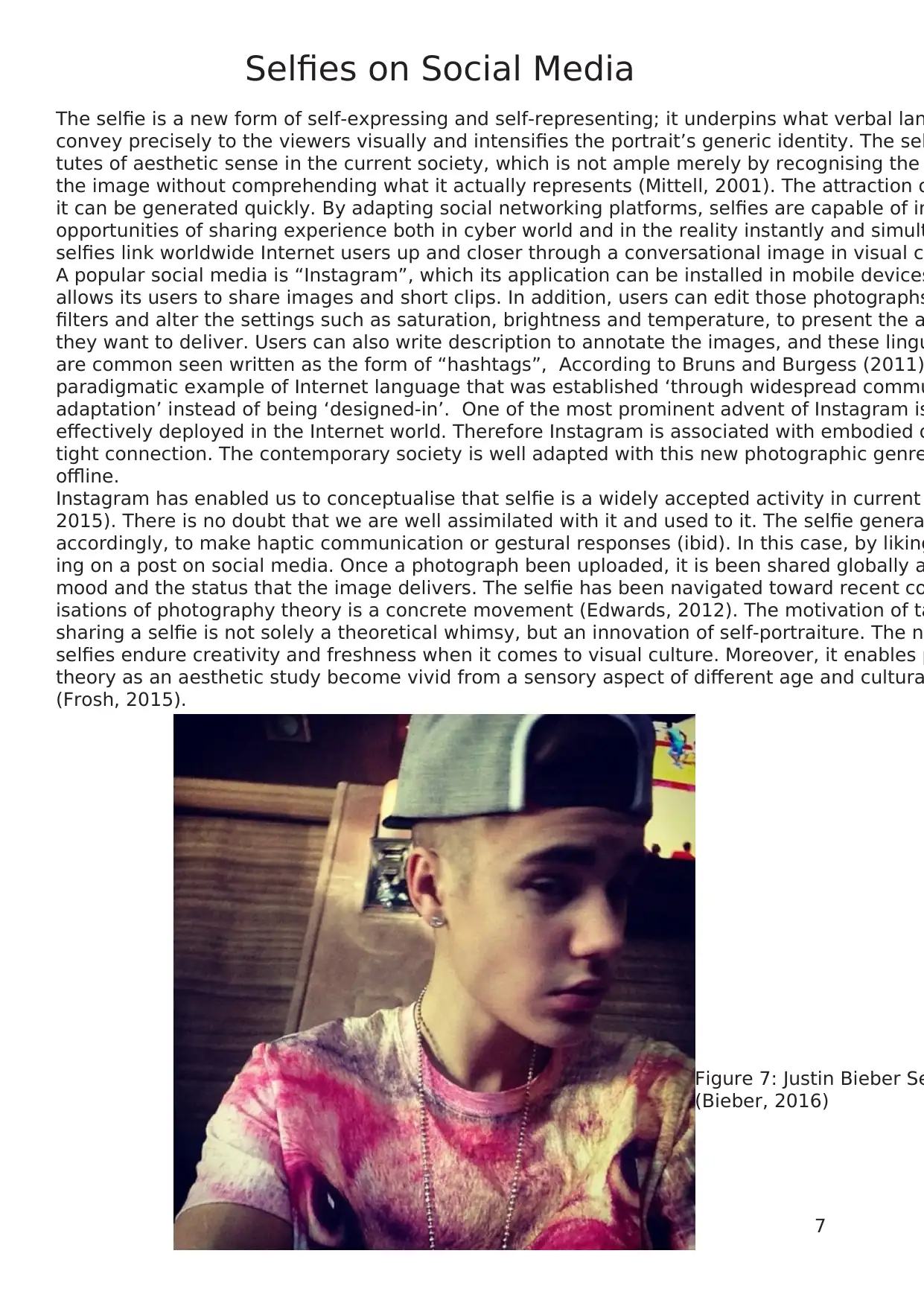
7
Selfies on Social Media
The selfie is a new form of self-expressing and self-representing; it underpins what verbal lan
convey precisely to the viewers visually and intensifies the portrait’s generic identity. The sel
tutes of aesthetic sense in the current society, which is not ample merely by recognising the
the image without comprehending what it actually represents (Mittell, 2001). The attraction o
it can be generated quickly. By adapting social networking platforms, selfies are capable of in
opportunities of sharing experience both in cyber world and in the reality instantly and simult
selfies link worldwide Internet users up and closer through a conversational image in visual c
A popular social media is “Instagram”, which its application can be installed in mobile devices
allows its users to share images and short clips. In addition, users can edit those photographs
filters and alter the settings such as saturation, brightness and temperature, to present the a
they want to deliver. Users can also write description to annotate the images, and these lingu
are common seen written as the form of “hashtags”, According to Bruns and Burgess (2011)
paradigmatic example of Internet language that was established ‘through widespread commu
adaptation’ instead of being ‘designed-in’. One of the most prominent advent of Instagram is
effectively deployed in the Internet world. Therefore Instagram is associated with embodied d
tight connection. The contemporary society is well adapted with this new photographic genre
offline.
Instagram has enabled us to conceptualise that selfie is a widely accepted activity in current
2015). There is no doubt that we are well assimilated with it and used to it. The selfie genera
accordingly, to make haptic communication or gestural responses (ibid). In this case, by liking
ing on a post on social media. Once a photograph been uploaded, it is been shared globally a
mood and the status that the image delivers. The selfie has been navigated toward recent co
isations of photography theory is a concrete movement (Edwards, 2012). The motivation of ta
sharing a selfie is not solely a theoretical whimsy, but an innovation of self-portraiture. The n
selfies endure creativity and freshness when it comes to visual culture. Moreover, it enables p
theory as an aesthetic study become vivid from a sensory aspect of different age and cultura
(Frosh, 2015).
Figure 7: Justin Bieber Se
(Bieber, 2016)
Selfies on Social Media
The selfie is a new form of self-expressing and self-representing; it underpins what verbal lan
convey precisely to the viewers visually and intensifies the portrait’s generic identity. The sel
tutes of aesthetic sense in the current society, which is not ample merely by recognising the
the image without comprehending what it actually represents (Mittell, 2001). The attraction o
it can be generated quickly. By adapting social networking platforms, selfies are capable of in
opportunities of sharing experience both in cyber world and in the reality instantly and simult
selfies link worldwide Internet users up and closer through a conversational image in visual c
A popular social media is “Instagram”, which its application can be installed in mobile devices
allows its users to share images and short clips. In addition, users can edit those photographs
filters and alter the settings such as saturation, brightness and temperature, to present the a
they want to deliver. Users can also write description to annotate the images, and these lingu
are common seen written as the form of “hashtags”, According to Bruns and Burgess (2011)
paradigmatic example of Internet language that was established ‘through widespread commu
adaptation’ instead of being ‘designed-in’. One of the most prominent advent of Instagram is
effectively deployed in the Internet world. Therefore Instagram is associated with embodied d
tight connection. The contemporary society is well adapted with this new photographic genre
offline.
Instagram has enabled us to conceptualise that selfie is a widely accepted activity in current
2015). There is no doubt that we are well assimilated with it and used to it. The selfie genera
accordingly, to make haptic communication or gestural responses (ibid). In this case, by liking
ing on a post on social media. Once a photograph been uploaded, it is been shared globally a
mood and the status that the image delivers. The selfie has been navigated toward recent co
isations of photography theory is a concrete movement (Edwards, 2012). The motivation of ta
sharing a selfie is not solely a theoretical whimsy, but an innovation of self-portraiture. The n
selfies endure creativity and freshness when it comes to visual culture. Moreover, it enables p
theory as an aesthetic study become vivid from a sensory aspect of different age and cultura
(Frosh, 2015).
Figure 7: Justin Bieber Se
(Bieber, 2016)
Paraphrase This Document
Need a fresh take? Get an instant paraphrase of this document with our AI Paraphraser
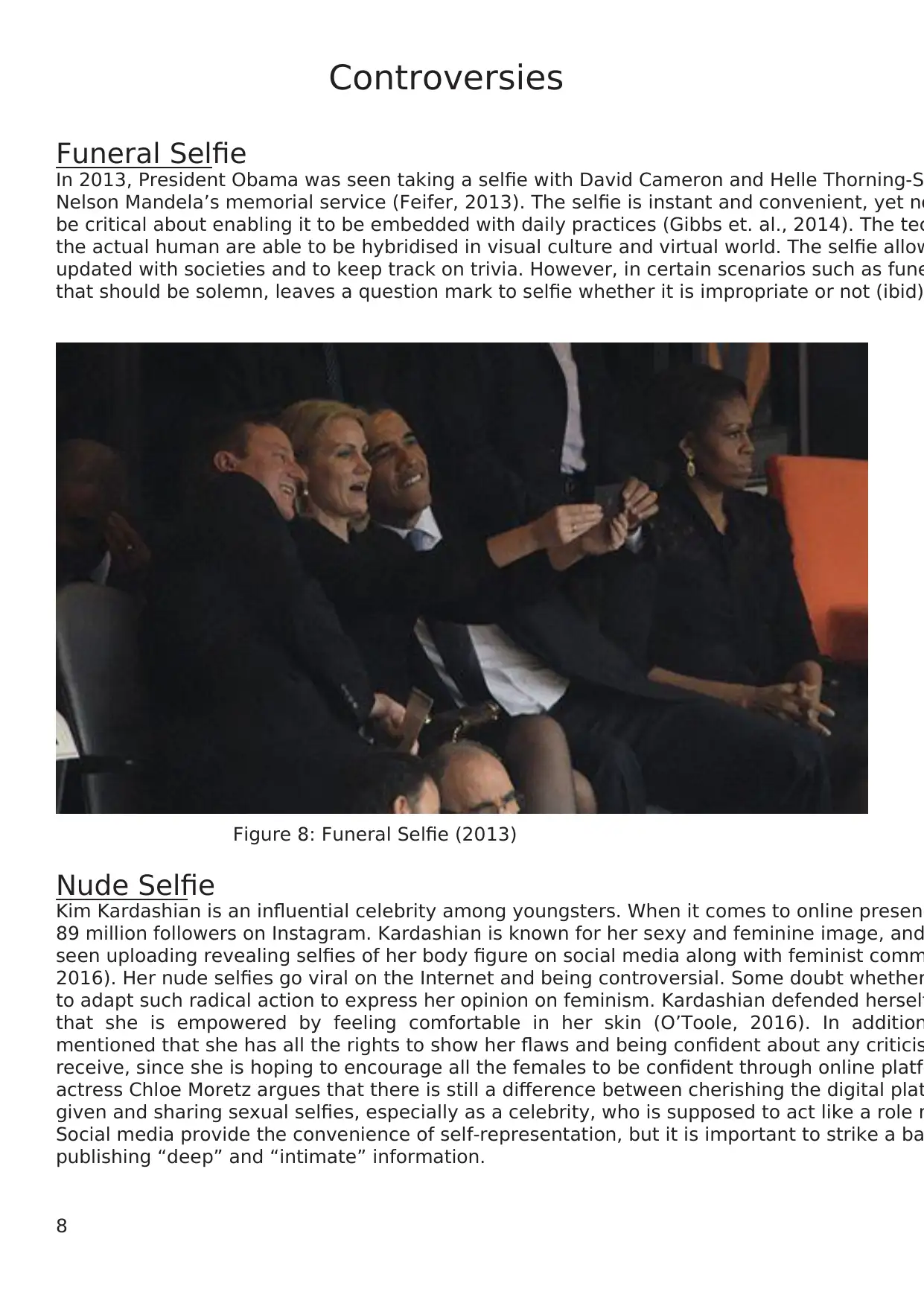
8
Controversies
Funeral Selfie
In 2013, President Obama was seen taking a selfie with David Cameron and Helle Thorning-S
Nelson Mandela’s memorial service (Feifer, 2013). The selfie is instant and convenient, yet no
be critical about enabling it to be embedded with daily practices (Gibbs et. al., 2014). The tec
the actual human are able to be hybridised in visual culture and virtual world. The selfie allow
updated with societies and to keep track on trivia. However, in certain scenarios such as fune
that should be solemn, leaves a question mark to selfie whether it is impropriate or not (ibid)
Nude Selfie
Kim Kardashian is an influential celebrity among youngsters. When it comes to online presenc
89 million followers on Instagram. Kardashian is known for her sexy and feminine image, and
seen uploading revealing selfies of her body figure on social media along with feminist comm
2016). Her nude selfies go viral on the Internet and being controversial. Some doubt whether
to adapt such radical action to express her opinion on feminism. Kardashian defended herself
that she is empowered by feeling comfortable in her skin (O’Toole, 2016). In addition
mentioned that she has all the rights to show her flaws and being confident about any criticis
receive, since she is hoping to encourage all the females to be confident through online platfo
actress Chloe Moretz argues that there is still a difference between cherishing the digital plat
given and sharing sexual selfies, especially as a celebrity, who is supposed to act like a role m
Social media provide the convenience of self-representation, but it is important to strike a ba
publishing “deep” and “intimate” information.
Figure 8: Funeral Selfie (2013)
Controversies
Funeral Selfie
In 2013, President Obama was seen taking a selfie with David Cameron and Helle Thorning-S
Nelson Mandela’s memorial service (Feifer, 2013). The selfie is instant and convenient, yet no
be critical about enabling it to be embedded with daily practices (Gibbs et. al., 2014). The tec
the actual human are able to be hybridised in visual culture and virtual world. The selfie allow
updated with societies and to keep track on trivia. However, in certain scenarios such as fune
that should be solemn, leaves a question mark to selfie whether it is impropriate or not (ibid)
Nude Selfie
Kim Kardashian is an influential celebrity among youngsters. When it comes to online presenc
89 million followers on Instagram. Kardashian is known for her sexy and feminine image, and
seen uploading revealing selfies of her body figure on social media along with feminist comm
2016). Her nude selfies go viral on the Internet and being controversial. Some doubt whether
to adapt such radical action to express her opinion on feminism. Kardashian defended herself
that she is empowered by feeling comfortable in her skin (O’Toole, 2016). In addition
mentioned that she has all the rights to show her flaws and being confident about any criticis
receive, since she is hoping to encourage all the females to be confident through online platfo
actress Chloe Moretz argues that there is still a difference between cherishing the digital plat
given and sharing sexual selfies, especially as a celebrity, who is supposed to act like a role m
Social media provide the convenience of self-representation, but it is important to strike a ba
publishing “deep” and “intimate” information.
Figure 8: Funeral Selfie (2013)
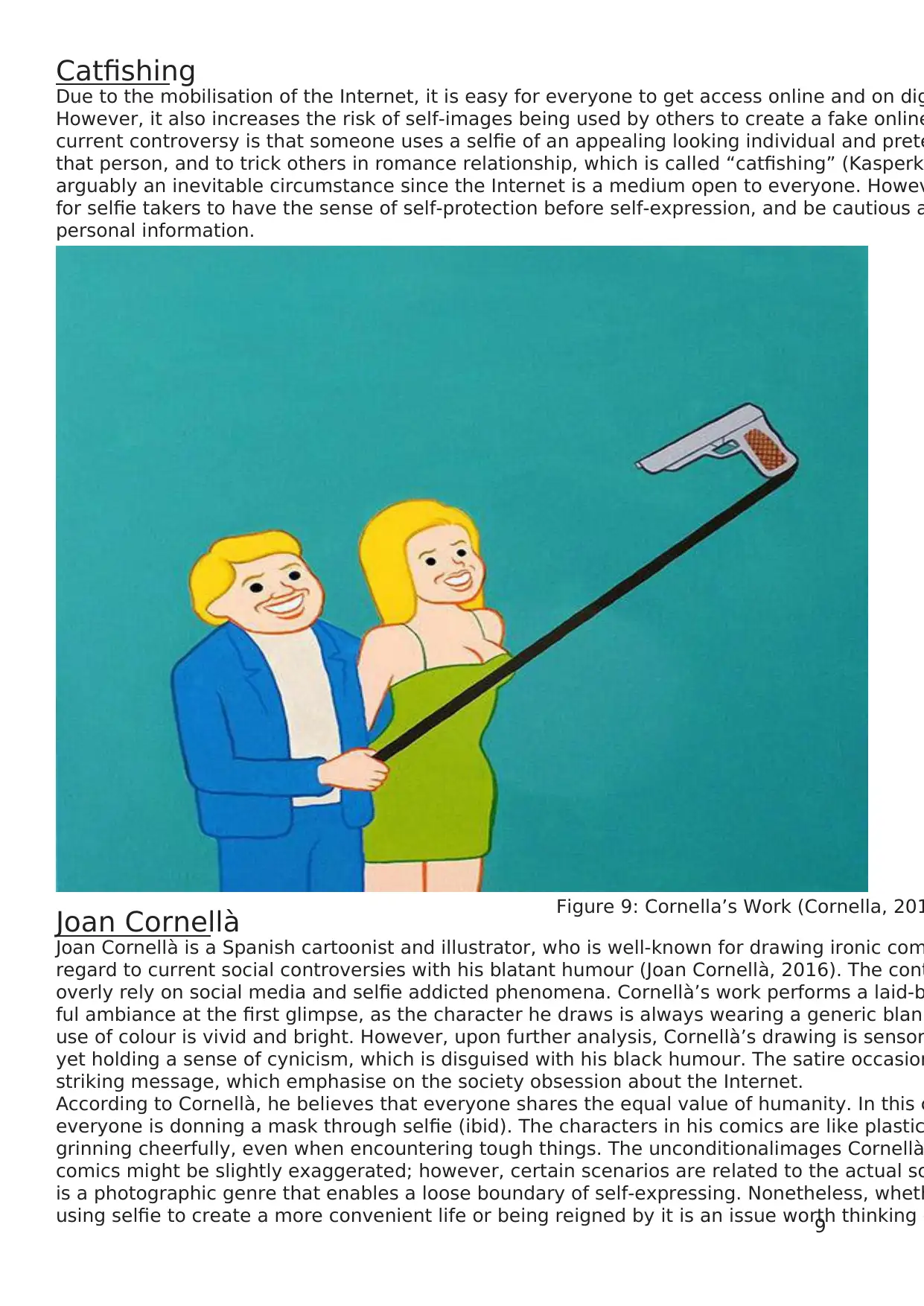
9
Catfishing
Due to the mobilisation of the Internet, it is easy for everyone to get access online and on dig
However, it also increases the risk of self-images being used by others to create a fake online
current controversy is that someone uses a selfie of an appealing looking individual and prete
that person, and to trick others in romance relationship, which is called “catfishing” (Kasperk
arguably an inevitable circumstance since the Internet is a medium open to everyone. Howev
for selfie takers to have the sense of self-protection before self-expression, and be cautious a
personal information.
Joan Cornellà
Joan Cornellà is a Spanish cartoonist and illustrator, who is well-known for drawing ironic com
regard to current social controversies with his blatant humour (Joan Cornellà, 2016). The cont
overly rely on social media and selfie addicted phenomena. Cornellà’s work performs a laid-b
ful ambiance at the first glimpse, as the character he draws is always wearing a generic blank
use of colour is vivid and bright. However, upon further analysis, Cornellà’s drawing is sensor
yet holding a sense of cynicism, which is disguised with his black humour. The satire occasion
striking message, which emphasise on the society obsession about the Internet.
According to Cornellà, he believes that everyone shares the equal value of humanity. In this c
everyone is donning a mask through selfie (ibid). The characters in his comics are like plastic
grinning cheerfully, even when encountering tough things. The unconditionalimages Cornellà
comics might be slightly exaggerated; however, certain scenarios are related to the actual so
is a photographic genre that enables a loose boundary of self-expressing. Nonetheless, wheth
using selfie to create a more convenient life or being reigned by it is an issue worth thinking c
Figure 9: Cornella’s Work (Cornella, 201
Catfishing
Due to the mobilisation of the Internet, it is easy for everyone to get access online and on dig
However, it also increases the risk of self-images being used by others to create a fake online
current controversy is that someone uses a selfie of an appealing looking individual and prete
that person, and to trick others in romance relationship, which is called “catfishing” (Kasperk
arguably an inevitable circumstance since the Internet is a medium open to everyone. Howev
for selfie takers to have the sense of self-protection before self-expression, and be cautious a
personal information.
Joan Cornellà
Joan Cornellà is a Spanish cartoonist and illustrator, who is well-known for drawing ironic com
regard to current social controversies with his blatant humour (Joan Cornellà, 2016). The cont
overly rely on social media and selfie addicted phenomena. Cornellà’s work performs a laid-b
ful ambiance at the first glimpse, as the character he draws is always wearing a generic blank
use of colour is vivid and bright. However, upon further analysis, Cornellà’s drawing is sensor
yet holding a sense of cynicism, which is disguised with his black humour. The satire occasion
striking message, which emphasise on the society obsession about the Internet.
According to Cornellà, he believes that everyone shares the equal value of humanity. In this c
everyone is donning a mask through selfie (ibid). The characters in his comics are like plastic
grinning cheerfully, even when encountering tough things. The unconditionalimages Cornellà
comics might be slightly exaggerated; however, certain scenarios are related to the actual so
is a photographic genre that enables a loose boundary of self-expressing. Nonetheless, wheth
using selfie to create a more convenient life or being reigned by it is an issue worth thinking c
Figure 9: Cornella’s Work (Cornella, 201
⊘ This is a preview!⊘
Do you want full access?
Subscribe today to unlock all pages.

Trusted by 1+ million students worldwide
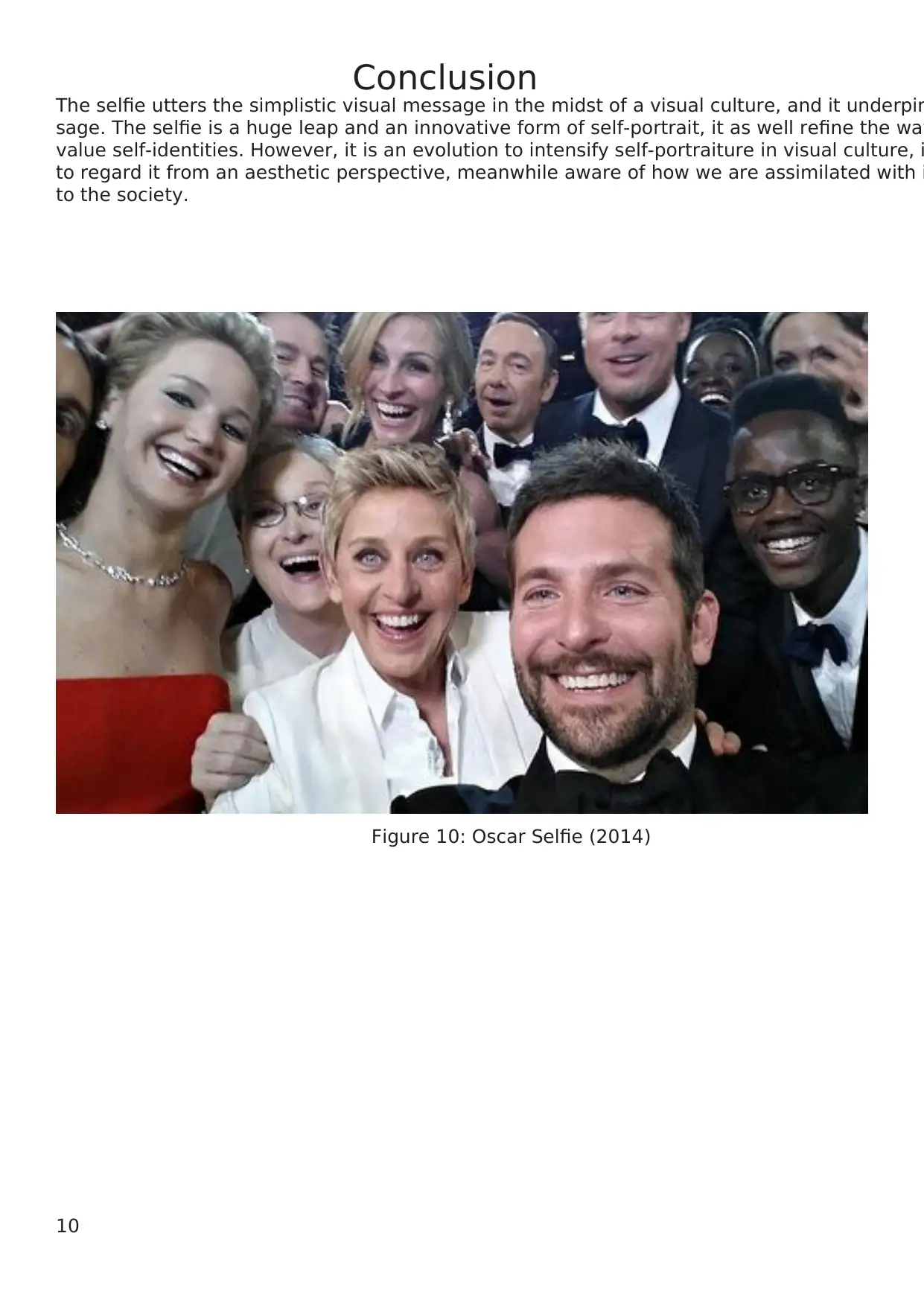
10
Conclusion
The selfie utters the simplistic visual message in the midst of a visual culture, and it underpin
sage. The selfie is a huge leap and an innovative form of self-portrait, it as well refine the way
value self-identities. However, it is an evolution to intensify self-portraiture in visual culture, i
to regard it from an aesthetic perspective, meanwhile aware of how we are assimilated with i
to the society.
Figure 10: Oscar Selfie (2014)
Conclusion
The selfie utters the simplistic visual message in the midst of a visual culture, and it underpin
sage. The selfie is a huge leap and an innovative form of self-portrait, it as well refine the way
value self-identities. However, it is an evolution to intensify self-portraiture in visual culture, i
to regard it from an aesthetic perspective, meanwhile aware of how we are assimilated with i
to the society.
Figure 10: Oscar Selfie (2014)
Paraphrase This Document
Need a fresh take? Get an instant paraphrase of this document with our AI Paraphraser
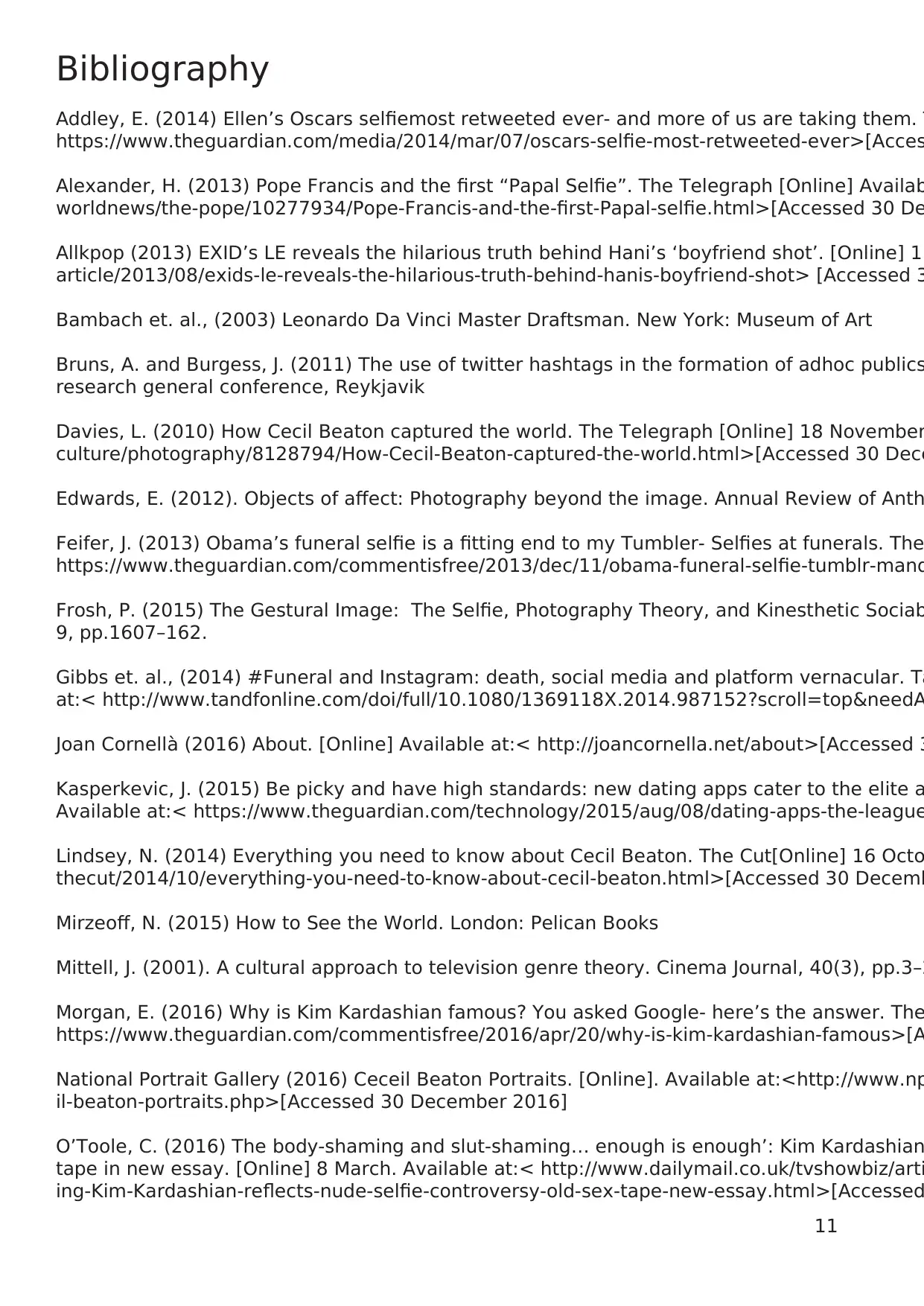
11
Bibliography
Addley, E. (2014) Ellen’s Oscars selfiemost retweeted ever- and more of us are taking them. T
https://www.theguardian.com/media/2014/mar/07/oscars-selfie-most-retweeted-ever>[Acces
Alexander, H. (2013) Pope Francis and the first “Papal Selfie”. The Telegraph [Online] Availab
worldnews/the-pope/10277934/Pope-Francis-and-the-first-Papal-selfie.html>[Accessed 30 De
Allkpop (2013) EXID’s LE reveals the hilarious truth behind Hani’s ‘boyfriend shot’. [Online] 1
article/2013/08/exids-le-reveals-the-hilarious-truth-behind-hanis-boyfriend-shot> [Accessed 3
Bambach et. al., (2003) Leonardo Da Vinci Master Draftsman. New York: Museum of Art
Bruns, A. and Burgess, J. (2011) The use of twitter hashtags in the formation of adhoc publics
research general conference, Reykjavik
Davies, L. (2010) How Cecil Beaton captured the world. The Telegraph [Online] 18 November
culture/photography/8128794/How-Cecil-Beaton-captured-the-world.html>[Accessed 30 Dece
Edwards, E. (2012). Objects of affect: Photography beyond the image. Annual Review of Anth
Feifer, J. (2013) Obama’s funeral selfie is a fitting end to my Tumbler- Selfies at funerals. The
https://www.theguardian.com/commentisfree/2013/dec/11/obama-funeral-selfie-tumblr-mand
Frosh, P. (2015) The Gestural Image: The Selfie, Photography Theory, and Kinesthetic Sociab
9, pp.1607–162.
Gibbs et. al., (2014) #Funeral and Instagram: death, social media and platform vernacular. Ta
at:< http://www.tandfonline.com/doi/full/10.1080/1369118X.2014.987152?scroll=top&needA
Joan Cornellà (2016) About. [Online] Available at:< http://joancornella.net/about>[Accessed 3
Kasperkevic, J. (2015) Be picky and have high standards: new dating apps cater to the elite a
Available at:< https://www.theguardian.com/technology/2015/aug/08/dating-apps-the-league
Lindsey, N. (2014) Everything you need to know about Cecil Beaton. The Cut[Online] 16 Octo
thecut/2014/10/everything-you-need-to-know-about-cecil-beaton.html>[Accessed 30 Decemb
Mirzeoff, N. (2015) How to See the World. London: Pelican Books
Mittell, J. (2001). A cultural approach to television genre theory. Cinema Journal, 40(3), pp.3–2
Morgan, E. (2016) Why is Kim Kardashian famous? You asked Google- here’s the answer. The
https://www.theguardian.com/commentisfree/2016/apr/20/why-is-kim-kardashian-famous>[A
National Portrait Gallery (2016) Ceceil Beaton Portraits. [Online]. Available at:<http://www.np
il-beaton-portraits.php>[Accessed 30 December 2016]
O’Toole, C. (2016) The body-shaming and slut-shaming… enough is enough’: Kim Kardashian
tape in new essay. [Online] 8 March. Available at:< http://www.dailymail.co.uk/tvshowbiz/arti
ing-Kim-Kardashian-reflects-nude-selfie-controversy-old-sex-tape-new-essay.html>[Accessed
Bibliography
Addley, E. (2014) Ellen’s Oscars selfiemost retweeted ever- and more of us are taking them. T
https://www.theguardian.com/media/2014/mar/07/oscars-selfie-most-retweeted-ever>[Acces
Alexander, H. (2013) Pope Francis and the first “Papal Selfie”. The Telegraph [Online] Availab
worldnews/the-pope/10277934/Pope-Francis-and-the-first-Papal-selfie.html>[Accessed 30 De
Allkpop (2013) EXID’s LE reveals the hilarious truth behind Hani’s ‘boyfriend shot’. [Online] 1
article/2013/08/exids-le-reveals-the-hilarious-truth-behind-hanis-boyfriend-shot> [Accessed 3
Bambach et. al., (2003) Leonardo Da Vinci Master Draftsman. New York: Museum of Art
Bruns, A. and Burgess, J. (2011) The use of twitter hashtags in the formation of adhoc publics
research general conference, Reykjavik
Davies, L. (2010) How Cecil Beaton captured the world. The Telegraph [Online] 18 November
culture/photography/8128794/How-Cecil-Beaton-captured-the-world.html>[Accessed 30 Dece
Edwards, E. (2012). Objects of affect: Photography beyond the image. Annual Review of Anth
Feifer, J. (2013) Obama’s funeral selfie is a fitting end to my Tumbler- Selfies at funerals. The
https://www.theguardian.com/commentisfree/2013/dec/11/obama-funeral-selfie-tumblr-mand
Frosh, P. (2015) The Gestural Image: The Selfie, Photography Theory, and Kinesthetic Sociab
9, pp.1607–162.
Gibbs et. al., (2014) #Funeral and Instagram: death, social media and platform vernacular. Ta
at:< http://www.tandfonline.com/doi/full/10.1080/1369118X.2014.987152?scroll=top&needA
Joan Cornellà (2016) About. [Online] Available at:< http://joancornella.net/about>[Accessed 3
Kasperkevic, J. (2015) Be picky and have high standards: new dating apps cater to the elite a
Available at:< https://www.theguardian.com/technology/2015/aug/08/dating-apps-the-league
Lindsey, N. (2014) Everything you need to know about Cecil Beaton. The Cut[Online] 16 Octo
thecut/2014/10/everything-you-need-to-know-about-cecil-beaton.html>[Accessed 30 Decemb
Mirzeoff, N. (2015) How to See the World. London: Pelican Books
Mittell, J. (2001). A cultural approach to television genre theory. Cinema Journal, 40(3), pp.3–2
Morgan, E. (2016) Why is Kim Kardashian famous? You asked Google- here’s the answer. The
https://www.theguardian.com/commentisfree/2016/apr/20/why-is-kim-kardashian-famous>[A
National Portrait Gallery (2016) Ceceil Beaton Portraits. [Online]. Available at:<http://www.np
il-beaton-portraits.php>[Accessed 30 December 2016]
O’Toole, C. (2016) The body-shaming and slut-shaming… enough is enough’: Kim Kardashian
tape in new essay. [Online] 8 March. Available at:< http://www.dailymail.co.uk/tvshowbiz/arti
ing-Kim-Kardashian-reflects-nude-selfie-controversy-old-sex-tape-new-essay.html>[Accessed
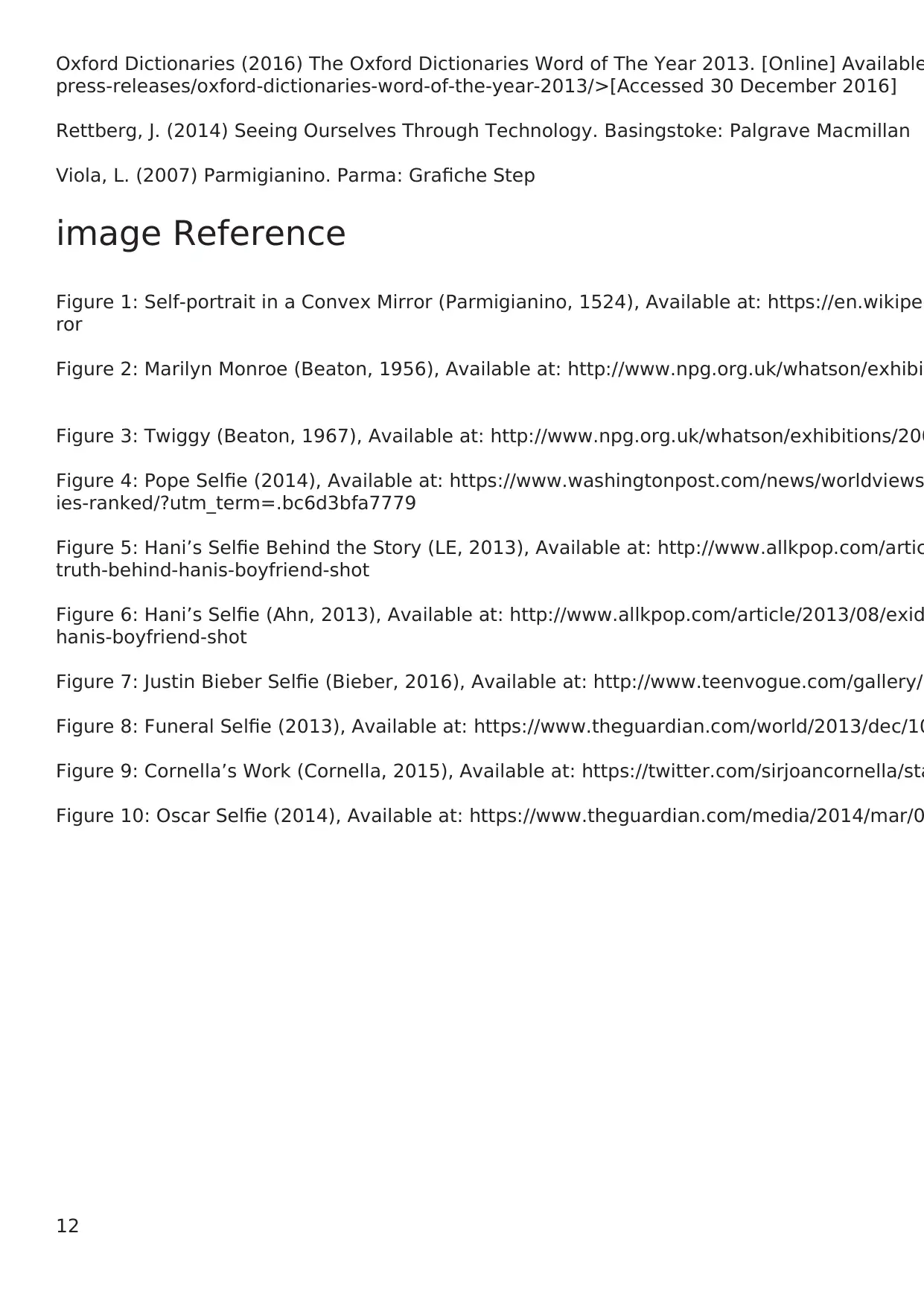
12
Oxford Dictionaries (2016) The Oxford Dictionaries Word of The Year 2013. [Online] Available
press-releases/oxford-dictionaries-word-of-the-year-2013/>[Accessed 30 December 2016]
Rettberg, J. (2014) Seeing Ourselves Through Technology. Basingstoke: Palgrave Macmillan
Viola, L. (2007) Parmigianino. Parma: Grafiche Step
image Reference
Figure 1: Self-portrait in a Convex Mirror (Parmigianino, 1524), Available at: https://en.wikiped
ror
Figure 2: Marilyn Monroe (Beaton, 1956), Available at: http://www.npg.org.uk/whatson/exhibi
Figure 3: Twiggy (Beaton, 1967), Available at: http://www.npg.org.uk/whatson/exhibitions/200
Figure 4: Pope Selfie (2014), Available at: https://www.washingtonpost.com/news/worldviews
ies-ranked/?utm_term=.bc6d3bfa7779
Figure 5: Hani’s Selfie Behind the Story (LE, 2013), Available at: http://www.allkpop.com/artic
truth-behind-hanis-boyfriend-shot
Figure 6: Hani’s Selfie (Ahn, 2013), Available at: http://www.allkpop.com/article/2013/08/exid
hanis-boyfriend-shot
Figure 7: Justin Bieber Selfie (Bieber, 2016), Available at: http://www.teenvogue.com/gallery/b
Figure 8: Funeral Selfie (2013), Available at: https://www.theguardian.com/world/2013/dec/10
Figure 9: Cornella’s Work (Cornella, 2015), Available at: https://twitter.com/sirjoancornella/sta
Figure 10: Oscar Selfie (2014), Available at: https://www.theguardian.com/media/2014/mar/0
Oxford Dictionaries (2016) The Oxford Dictionaries Word of The Year 2013. [Online] Available
press-releases/oxford-dictionaries-word-of-the-year-2013/>[Accessed 30 December 2016]
Rettberg, J. (2014) Seeing Ourselves Through Technology. Basingstoke: Palgrave Macmillan
Viola, L. (2007) Parmigianino. Parma: Grafiche Step
image Reference
Figure 1: Self-portrait in a Convex Mirror (Parmigianino, 1524), Available at: https://en.wikiped
ror
Figure 2: Marilyn Monroe (Beaton, 1956), Available at: http://www.npg.org.uk/whatson/exhibi
Figure 3: Twiggy (Beaton, 1967), Available at: http://www.npg.org.uk/whatson/exhibitions/200
Figure 4: Pope Selfie (2014), Available at: https://www.washingtonpost.com/news/worldviews
ies-ranked/?utm_term=.bc6d3bfa7779
Figure 5: Hani’s Selfie Behind the Story (LE, 2013), Available at: http://www.allkpop.com/artic
truth-behind-hanis-boyfriend-shot
Figure 6: Hani’s Selfie (Ahn, 2013), Available at: http://www.allkpop.com/article/2013/08/exid
hanis-boyfriend-shot
Figure 7: Justin Bieber Selfie (Bieber, 2016), Available at: http://www.teenvogue.com/gallery/b
Figure 8: Funeral Selfie (2013), Available at: https://www.theguardian.com/world/2013/dec/10
Figure 9: Cornella’s Work (Cornella, 2015), Available at: https://twitter.com/sirjoancornella/sta
Figure 10: Oscar Selfie (2014), Available at: https://www.theguardian.com/media/2014/mar/0
⊘ This is a preview!⊘
Do you want full access?
Subscribe today to unlock all pages.

Trusted by 1+ million students worldwide
1 out of 12
Your All-in-One AI-Powered Toolkit for Academic Success.
+13062052269
info@desklib.com
Available 24*7 on WhatsApp / Email
![[object Object]](/_next/static/media/star-bottom.7253800d.svg)
Unlock your academic potential
Copyright © 2020–2025 A2Z Services. All Rights Reserved. Developed and managed by ZUCOL.


